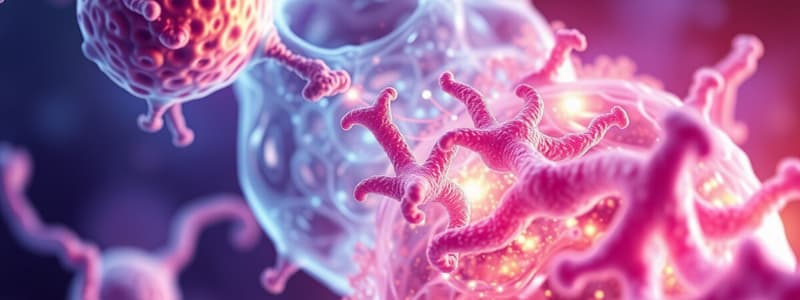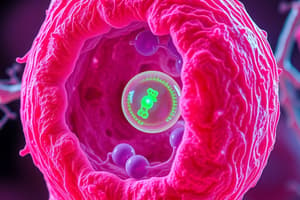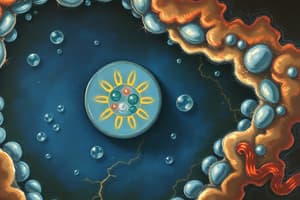Podcast
Questions and Answers
Cells are the building blocks of all plants and ______.
Cells are the building blocks of all plants and ______.
animals
Fluid between cells is called ______ fluid.
Fluid between cells is called ______ fluid.
interstitial
The cell membrane is made up of a double layer of ______ molecules.
The cell membrane is made up of a double layer of ______ molecules.
phospholipid
Two classes of cells in the human body are sex cells and ______ cells.
Two classes of cells in the human body are sex cells and ______ cells.
Membrane proteins can be classified into integral proteins and ______ proteins.
Membrane proteins can be classified into integral proteins and ______ proteins.
Cytology is the study of cell ______ and function.
Cytology is the study of cell ______ and function.
The cell membrane selectively transports nutrients into and ______ out of the cell.
The cell membrane selectively transports nutrients into and ______ out of the cell.
The smallest units that perform all vital physiological ______ are cells.
The smallest units that perform all vital physiological ______ are cells.
DNA carries instructions to produce every ______ in the body.
DNA carries instructions to produce every ______ in the body.
The DNA instructions for one protein make up a ______.
The DNA instructions for one protein make up a ______.
The chemical language of DNA instructions is the genetic ______.
The chemical language of DNA instructions is the genetic ______.
Every group of three bases is known as the ______ code.
Every group of three bases is known as the ______ code.
The first step in protein production is ______ activation.
The first step in protein production is ______ activation.
RNA polymerase copies the complete code for the protein onto a strand of messenger ______.
RNA polymerase copies the complete code for the protein onto a strand of messenger ______.
In the resulting mRNA strand, each group of 3 nucleotides is a ______ representing one amino acid.
In the resulting mRNA strand, each group of 3 nucleotides is a ______ representing one amino acid.
Translation begins when an mRNA strand is bound between a small and a large ______ unit.
Translation begins when an mRNA strand is bound between a small and a large ______ unit.
Cells in a malignant tumor spread into surrounding tissues and start new tumors, a process known as ______.
Cells in a malignant tumor spread into surrounding tissues and start new tumors, a process known as ______.
An illness that disrupts normal cellular controls and produces malignant cells is called ______.
An illness that disrupts normal cellular controls and produces malignant cells is called ______.
Mutated genes that disrupt normal cellular controls are known as ______.
Mutated genes that disrupt normal cellular controls are known as ______.
Cancers often begin where ______ are dividing rapidly.
Cancers often begin where ______ are dividing rapidly.
All your body cells (except sex cells) contain the same ______ chromosomes.
All your body cells (except sex cells) contain the same ______ chromosomes.
A human being grows from 1 cell to ______ cells by cell division.
A human being grows from 1 cell to ______ cells by cell division.
Most of a cell’s life is spent in a non-dividing state called ______.
Most of a cell’s life is spent in a non-dividing state called ______.
For body cells to divide, their genetic material must be duplicated exactly in a process called ______.
For body cells to divide, their genetic material must be duplicated exactly in a process called ______.
Mitosis occurs in ______ stages.
Mitosis occurs in ______ stages.
The second stage of mitosis is called ______.
The second stage of mitosis is called ______.
During anaphase, chromosomes pull apart into ______ daughter chromosomes.
During anaphase, chromosomes pull apart into ______ daughter chromosomes.
Cytokinesis is the division of the ______ of the cell into 2 daughter cells.
Cytokinesis is the division of the ______ of the cell into 2 daughter cells.
A ______ tumor is contained and not life threatening.
A ______ tumor is contained and not life threatening.
Anchoring proteins attach the cell membrane to inside or outside ______.
Anchoring proteins attach the cell membrane to inside or outside ______.
Recognition proteins label cells as normal or abnormal to the ______ system.
Recognition proteins label cells as normal or abnormal to the ______ system.
Enzymes catalyze reactions inside or outside the ______.
Enzymes catalyze reactions inside or outside the ______.
Carrier proteins transport ______ through the cell membrane using energy.
Carrier proteins transport ______ through the cell membrane using energy.
The two components of cytoplasm are cytosol and ______.
The two components of cytoplasm are cytosol and ______.
Microvilli are finger-shaped projections that increase surface area for ______.
Microvilli are finger-shaped projections that increase surface area for ______.
Ribosomes carry out orders from the nucleus for ______ synthesis.
Ribosomes carry out orders from the nucleus for ______ synthesis.
Cilia are long extensions of the cell membrane that move ______ across the cell surface.
Cilia are long extensions of the cell membrane that move ______ across the cell surface.
Flashcards are hidden until you start studying
Study Notes
Cellular Level of Organization
- Cell theory established by Robert Hooke in 1665 outlines that cells are the fundamental units of life, originating from preexisting cells, and maintaining homeostasis.
- Two classes of cells in the human body: sex cells (germ cells) for reproduction, and somatic cells for body functions.
- The cell membrane, or plasma membrane, separates the cytoplasm from the extracellular fluid, functioning as a selective barrier for nutrient transport.
Cell Membrane Structure and Function
- Composed of a phospholipid bilayer with hydrophilic heads facing outward, providing a semi-permeable barrier.
- Membrane proteins classified as integral (embedded) and peripheral (attached to surfaces).
- Six specialized functions of membrane proteins:
- Anchoring proteins: connect the membrane to other structures.
- Recognition proteins: identify normal or abnormal cells to the immune system.
- Enzymes: facilitate chemical reactions on either side of the membrane.
- Receptor proteins: bind to signaling molecules such as hormones.
- Carrier proteins: transport substances across the membrane using energy.
- Channels: pores that manage the flow of water and specific solutes.
Membrane Carbohydrates
- Carbohydrates protrude from the cell membrane, serving roles in:
- Lubrication and protection of the cell surface.
- Anchoring and motility.
- Specific binding for receptors.
- Immune recognition processes.
Cytoplasm and Organelles
- Cytoplasm consists of cytosol (intracellular fluid) and organelles, the functional structures within the cell.
- Six nonmembranous organelles:
- Cytoskeleton: provides structural support and shape.
- Microvilli: projections that enhance absorption surface area.
- Centrioles: aid in cell division by forming spindle fibers.
- Cilia: move fluids across the cell surface.
- Ribosomes: synthesize proteins by translating mRNA instructions.
Genetic Code and Protein Synthesis
- The information for protein synthesis is encoded in DNA, with genes dictating amino acid sequences.
- The genetic code comprises sequences of nitrogenous bases (A, T, C, G); every triplet of bases (codon) corresponds to an amino acid.
- Gene activation begins transcription, where RNA polymerase transcribes DNA into messenger RNA (mRNA) by substituting uracil for thymine.
- After transcription, mRNA exits the nucleus through nuclear pores to ribosomes, where translation occurs to synthesize proteins.
The Cell Life Cycle
- A human develops from a single cell to approximately 75 trillion cells through cell division.
- Cells are primarily in interphase, a non-dividing state where they perform their functions and prepare for division.
- Mitosis consists of four key stages:
- Prophase: Chromosomes condense into chromatids.
- Metaphase: Chromosomes align at the cell's center (metaphase plate).
- Anaphase: Sister chromatids separate into daughter chromosomes.
- Telophase: Nuclear membranes reform, and chromosomes decondense, resulting in two nuclei.
Cytokinesis and Cell Division
- Cytokinesis is the final step of cell division, splitting the cytoplasm to create two daughter cells.
- Tumors can develop from unregulated cell growth, with benign tumors remaining contained while malignant tumors (cancer) can spread (metastasis).
- Cancer arises from mutations affecting normal cellular control mechanisms.
Cell Diversity and Differentiation
- Each body cell, except sex cells, contains 46 chromosomes, but differentiation occurs as cells activate specific genes while deactivating others to fulfill specialized functions (e.g., liver cells, neurons).
- Cell diversity results from selective gene expression, establishing distinct cellular roles in tissues.
Studying That Suits You
Use AI to generate personalized quizzes and flashcards to suit your learning preferences.




